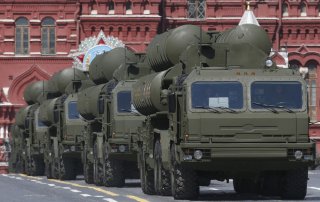India Wants Russia's Killer S-400 Air Defense System ASAP
Russia will find foreign buyers for the S-400 Triumf, and if India doesn’t obtain the system, then its rival Pakistan could.
Even as tensions between China and India along the Line of Actual Control (LAC), the poorly demarcated border between the two nations, have relaxed in recent months, the government in New Delhi wants to be prepared should it face an armed conflict with its regional adversary. This month India requested that Russia expedite the delivery of the S-400 Triumf air defense system.
The two nations have already signed a $5.43 billion contract for the S-400 Triumf “SA-21Growler,” a long-range surface-to-air missile (SAM) system, which would include a total of five regimental kits. It can utilize four different types of missiles with ranges between 40 kilometers, 100 kilometers, 200 kilometers and 400 kilometers, and can be used to detect and destroy high and low targets.
A team from the Indian Air Force has already been deployed to Moscow to undergo training to operate the system as soon as it arrives.
However, there could be numerous hurdles to clear before the systems are delivered.
As the India-based Financial Express recently reported, there have been technology-related issues that have slowed the production, acceptance and transfer of equipment. Another issue is that in 2017, the Trump administration introduced the Countering America's Adversaries Through Sanctions Act (CAATSA), which would bar Russia from exporting the system to India.
For its part, India has maintained that the process to acquire the S-400 Triumf began before CAATSA was imposed by the United States, and also argued it is not a United Nations law.
Bizarre Love Triangle
New Delhi is now balancing its partnership with Washington and that with long-time regional partner Moscow, with the latter going back to the early days of the Cold War. India has moved closer to the United States; and in March the leaders of Australia, India, Japan and the United States met for the Quadrilateral Security Dialogue—known as "the Quad—with a common goal of addressing Chinese aggression.
However, at the same time, India is unlikely to sacrifice its longstanding relationship with Moscow.
Where the situation becomes tricky is that some lawmakers have put pressure on the Biden administration to sanction India—and those calls have come not from Republicans but from those in Biden’s own party.
“If India chooses to go forward with its purchase of the S-400, that act will clearly constitute a significant, and therefore sanctionable, transaction with the Russian defense sector under Section 231 of CAATSA,” warned Senator Bob Menendez (D-N.J.), chair of the U.S. Senate Foreign Relations Committee.
The balancing act will also have to factor in Turkey, a U.S. ally and NATO partner, which also bought the S-400 missile system. That resulted in the expulsion of Ankara from the Lockheed Martin F-35 Joint Strike Fighter program. If the Biden administration were to give India a waiver and allow New Delhi to go forward with the S-400, it sets up a situation where the same might be necessary for Turkey.
Any sanctions by the United States could simply have India taking its money to Moscow. In 2020, as India sought to modernize its military, it purchased more than $3.4 billion in weapons from the United States. That was up from just $6.2 million in 2019, reported TRT World.
Kenneth I. Juster, who served as the twenty-fifth U.S. ambassador to the Republic of India, recently warned that CAATSA could damage U.S.-India Relations.
Writing for War On the Rocks, Juster explained, India, which is neither an ally nor an adversary of the United States, has a long history of purchasing military hardware from the Soviet Union and later Russia. But India has gradually diversified its inventory of military supplies in recent years, with increased purchases from the United States since 2008, which now total over $20 billion. “The purchases include important naval assets, such as the P-8I maritime patrol and anti-submarine aircraft and the MH-60 Romeo helicopter, which will enhance maritime security in the Indian Ocean region.”
A final consideration is that Moscow will find foreign buyers for the S-400 Triumf, and if India doesn’t obtain the system, then its rival Pakistan could. According to recent reports from the EurAsian Times, a senior Pakistani official said that Moscow has given Islamabad a “blank cheque” on the matter.
Given such options of having Pakistan armed with the S-400 platform, India may opt to stick with Moscow and move away from Washington.
Peter Suciu is a Michigan-based writer who has contributed to more than four dozen magazines, newspapers and websites. He regularly writes about military small arms, and is the author of several books on military headgear including A Gallery of Military Headdress, which is available on Amazon.com.
Image: Reuters

